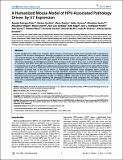Por favor, use este identificador para citar o enlazar a este item:
http://hdl.handle.net/10261/111368COMPARTIR / EXPORTAR:
 SHARE SHARE
 CORE
BASE CORE
BASE
|
|
| Visualizar otros formatos: MARC | Dublin Core | RDF | ORE | MODS | METS | DIDL | DATACITE | |

| Título: | A humanized mouse model of HPV-associated pathology driven by E7 expression |
Autor: | Buitrago-Pérez, Águeda; Santos, Almudena CSIC; Ribas, Catalina CSIC ORCID; García-Escudero, Ramón CSIC ORCID | Fecha de publicación: | 2012 | Editor: | Public Library of Science | Citación: | PLoS ONE 7 (7): e41743 (2012) | Resumen: | Human papillomavirus (HPV) is the causative agent of human cervical cancer and has been associated with oropharyngeal squamous cell carcinoma development. Although prophylactic vaccines have been developed, there is a need to develop new targeted therapies for individuals affected with malignant infected lesions in these locations, which must be tested in appropriate models. Cutaneous beta HPV types appear to be involved in skin carcinogenesis. Virus oncogenicity is partly achieved by inactivation of retinoblastoma protein family members by the viral E7 gene. Here we show that the E7 protein of cutaneous beta HPV5 binds pRb and promotes its degradation. In addition, we described an in vivo model of HPV-associated disease in which artificial human skin prepared using primary keratinocytes engineered to express the E7 protein is engrafted onto nude mice. Expression of E7 in the transplants was stably maintained for up to 6 months, inducing the appearance of lesions that, in the case of HPV16 E7, histologically resembled human anogenital lesions caused by oncogenic HPVs. Moreover, it was confirmed through biomarker expression analysis via immunodetection and/or quantitative PCR from mRNA and miRNA that the 16E7-modified engrafted skin shares molecular features with human HPV-associated pretumoral and tumoral lesions. Finally, our findings indicate a decrease of the in vitro capacity of HPV5 E7 to reduce pRb levels in vivo, possibly explaining the phenotypical differences when compared with 16E7-grafts. Our model seems to be a valuable platform for basic research into HPV oncogenesis and preclinical testing of HPV-associated antitumor therapies. © 2012 Buitrago-Perez et al. | URI: | http://hdl.handle.net/10261/111368 | DOI: | 10.1371/journal.pone.0041743 | Identificadores: | doi: 10.1371/journal.pone.0041743 issn: 1932-6203 |
| Aparece en las colecciones: | (CBM) Artículos |
Ficheros en este ítem:
| Fichero | Descripción | Tamaño | Formato | |
|---|---|---|---|---|
| C_Ribas_A_Humanized.pdf | 2,78 MB | Adobe PDF |  Visualizar/Abrir |
CORE Recommender
PubMed Central
Citations
14
checked on 21-mar-2024
SCOPUSTM
Citations
24
checked on 15-abr-2024
WEB OF SCIENCETM
Citations
21
checked on 27-feb-2024
Page view(s)
281
checked on 20-abr-2024
Download(s)
235
checked on 20-abr-2024
Google ScholarTM
Check
Altmetric
Altmetric
Artículos relacionados:
NOTA: Los ítems de Digital.CSIC están protegidos por copyright, con todos los derechos reservados, a menos que se indique lo contrario.
